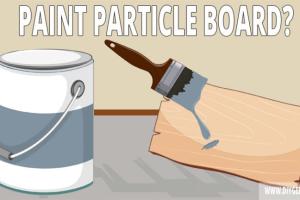A Comprehensive Guide to Painting Particle Board for a Stunning Finish

-
Quick Links:
- Introduction
- Understanding Particle Board
- Preparation Steps
- Choosing the Right Paint
- Painting Techniques
- Finishing Touches
- Case Study: Transforming a Particle Board Table
- Expert Insights
- Common Mistakes to Avoid
- FAQs
Introduction
Particle board is an affordable and versatile material commonly used in furniture and cabinetry. However, it often lacks the aesthetic appeal of solid wood. Fortunately, you can easily transform any particle board piece with a fresh coat of paint. This guide will walk you through the entire process, ensuring you achieve a professional-looking finish.
Understanding Particle Board
Particle board is made from wood chips, sawmill shavings, or even sawdust that are bonded together using adhesives under heat and pressure. This material is lightweight and cost-effective, making it popular for budget-friendly furniture solutions.
While particle board is a practical choice, it has a few downsides, such as:
- Susceptibility to moisture damage
- Less durability compared to solid wood
- Limited aesthetic appeal
Despite these drawbacks, painting particle board can improve its appearance and protect it from wear and tear.
Preparation Steps
Gathering Tools and Materials
Before you start painting, you need to gather the right tools and materials:
- Sandpaper (120 and 220 grit)
- Primer suitable for particle board
- Paint (latex or acrylic recommended)
- Paintbrushes and rollers
- Drop cloths
- Masking tape
- Protective gear (gloves, mask, goggles)
Cleaning the Surface
Begin by thoroughly cleaning the particle board surface to remove any dust, grease, or grime. Use a damp cloth and a mild detergent, then allow it to dry completely.
Repairing Damage
Inspect the particle board for any chips, scratches, or dents. Use wood filler to repair any imperfections. Once the filler is dry, sand the area smooth.
Choosing the Right Paint
Choosing the appropriate paint is crucial for achieving a durable finish. Consider the following options:
- Latex Paint: Easy to clean and dries quickly.
- Acrylic Paint: Offers a harder finish and better adhesion.
- Chalk Paint: Provides a matte finish and requires minimal prep work.
Make sure to select a paint that is suitable for use on furniture and offers good coverage.
Painting Techniques
Applying Primer
Primer is essential for particle board as it helps the paint adhere better and prevents moisture absorption. Follow these steps:
- Apply a thin coat of primer with a paintbrush or roller.
- Allow the primer to dry completely according to the manufacturer’s instructions.
- Sand lightly with 220 grit sandpaper to ensure a smooth surface.
Painting the Surface
Once the primer is dry, you can start painting:
- Begin with a thin coat of paint, using a brush for edges and a roller for flat surfaces.
- Let the first coat dry completely before applying a second coat.
- Sand lightly between coats for the best finish.
Finishing Touches
To protect your newly painted particle board, consider applying a clear protective finish, such as polyurethane. This step will enhance durability and longevity.
Follow these steps for applying a protective finish:
- Choose a water-based or oil-based polyurethane, depending on your preference.
- Apply a thin coat using a clean brush.
- Allow it to dry and sand lightly before applying additional coats.
Case Study: Transforming a Particle Board Table
To illustrate the effectiveness of this guide, let’s explore a real-world case where an old particle board dining table was transformed:
Before
The table had scratches, stains, and an outdated color. It was no longer appealing to the homeowners.
Process
The homeowners followed the guide meticulously:
- Cleaned and repaired the surface.
- Applied primer and two coats of acrylic paint.
- Finished with a clear polyurethane coat for protection.
After
The transformation was remarkable, turning a dull, worn table into a vibrant centerpiece for their dining room.
Expert Insights
According to interior designer Emily Henderson, “Painting particle board is a fantastic way to breathe new life into old furniture. Don’t be afraid to experiment with colors and textures to match your style!”
Common Mistakes to Avoid
Here are some common pitfalls to watch out for:
- Skipping the primer, which can lead to chipping paint.
- Using the wrong type of paint that doesn't adhere well.
- Rushing the drying process between coats.
FAQs
1. Can I paint particle board without sanding?
While it's possible, sanding provides better adhesion for the paint.
2. What type of primer should I use on particle board?
Use a high-quality oil or latex-based primer for best results.
3. How long should I wait between coats of paint?
Typically, 1-2 hours is sufficient, but always check the manufacturer's instructions.
4. Can I use spray paint on particle board?
Yes, spray paint can work well but ensure to use even strokes and multiple thin coats.
5. How do I clean painted particle board?
Use a damp cloth with mild soap for regular cleaning, avoiding harsh chemicals.
6. Is it necessary to seal painted particle board?
Yes, sealing protects the paint from scratches and moisture damage.
7. Can I repaint particle board furniture?
Absolutely! Just ensure to prep and clean the surface properly before repainting.
8. How do I prevent paint from peeling on particle board?
Proper prep work, including sanding and priming, will help prevent peeling.
9. Can I use chalk paint on particle board?
Yes, chalk paint can be used for a matte finish and easy application.
10. What colors work best for painting particle board?
Bright colors can add vibrancy, while neutral tones offer a classic look.
Conclusion
Painting particle board furniture is a cost-effective way to revitalize your home. By following this step-by-step guide, you can achieve a professional finish that enhances your decor. Remember to take your time during preparation and painting for the best results.